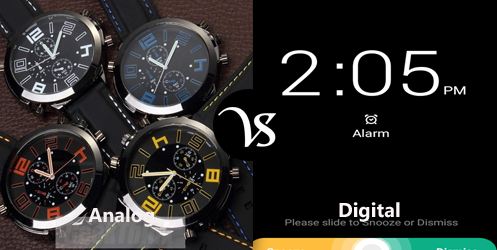 Analog:
Analog:
An analog signal is any continuous signal for which the time varying feature of the signal is a representation of some other time varying quantity, i.e. analogous to another time varying signal. The term analog signal usually refers to electrical signals however mechanical, pneumatic, hydraulic and other systems may also convey analog signals.
Digital:
Digital describes electronic technology that generates stores and processes data in terms of two states: positive and non-positive. Positive is expressed or represented by the number 1 and non-positive is expressed as the string of 0’s and 1’s. Each of these state digits is referred to as a bit. Digital technology is used as with new physical communications media, such as satellite, and fiber optic transmission.
Differences:
| Basis | Analog | Digital |
|---|---|---|
| Definition (www.oxforddictionaries.com) | Relating to or using signals or information represented by a continuously variable physical quantity such as spatial position or voltage. | (Of signals or data) expressed as series of the digits 0 and 1, typically represented by values of a physical quantity such as voltage or magnetic polarization. |
| Synonyms | Likeness, semblance, additive, hourglass, elongate, copy | Numerical, cardinal, dentate, digitate, decimal, computer |
| Antonyms | Numeric, numerical | Analogue, parallel, latitude, linear |
| History | The company was founded by two MIT graduates, Ray Stata and Matthew Lorber in 1965. The same year, the company released its first product, the model 101 op amp, which was a hockey-puck sized module used in test and measurement equipment. In 1967, the company published the first issue of its technical magazine, Analog Dialogue. | Digital communication became economical for widespread adoption after the invention of the personal computer. Claude Shannon, a Bell Labs mathematician, is credited for having laid out the foundations of digitalization in his pioneering 1948 article, A Mathematical Theory of Communication.[ |
| Word origin | The word analog was originated in Early 19th century: from French, from Greek analogon, neuter of analogos ‘proportionate’. | The word digital was originated in Late 15th century: from Latin digitalis, from digitus ‘finger, toe’. |
| Denoted by | It is denoted by sine waves. | It is denoted by square waves. |
| Flexibility | Analog hardware is not flexible. | Digital hardware is flexible in implementation. |
| Suits | It can be used in analog devices only. It is best suited for radio and audio transmission. | It is best suited for Computing and digital electronics. |
| Usage | It uses continuous range of values to represent information. | It uses discrete or discontinuous values to represent information. |
| Pronunciation |
|
|
| Draws | Analog instruments draw large power. | Digital instruments draw only negligible power. |
| Cost | It has a low cost and portable. | Cost is high and not easily portable (able to be easily carried or moved). |
| Conversion | Converting an analog signal to a digital signal is known as ADC. | Converting a digital signal to an analog signal is known as DAC (digital to analog conversion). |
| Example in Sentence |
|
|





